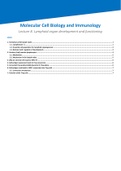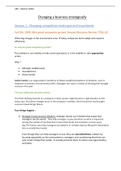College aantekeningen
Lecture 8. Lymphoid organ development and functioning (AM_470656)
- Vak
- Instelling
- Boek
Lecture on lymphoid organ development and functioning containing formation of the lymph nodes, information on lymphotoxin alfa, cell population in lymphoid organogenesis, retinoic acid and the role in development, the control of self-reactive lymphocytes, stromal cells and MHC-II expression, self-a...
[Meer zien]





